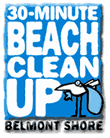| |
|
| |
BEACH BUDDIES:
THANKS for taking the time to visit our site. I hope that you will find some useful information about how you can get involved in helping to keep our beaches safe and clean. It's important that we be good stewards of our surf and sand so that we and our aquatic animal friends can enjoy our coast.
Justin Rudd!
30-Minute Beach Cleanup
Founder/organizer
g TAX-DEDUCTIBLE GIFT
Please Support Beach Cleanups
 RIGHT NOW, while the need is in your mind, won't you please donate? RIGHT NOW, while the need is in your mind, won't you please donate?
WE HOPE YOU share our love for animals, kids and the environment, and our wish is that you'll consider a gift of $25, $50, $100 or another amount so that we can continue to bring you clean and safe beaches.
CHECKS to BEACH CLEANUP, Attn. Justin Rudd, 3040 E. First Street, Long Beach, CA 90803.
|
THE MAIN PURPOSE of the Community Action Team (CAT) is to promote social well-being among the general public. As a 501c3 nonprofit corporation governed by a board of directors, contributions to CAT are tax deductible and are used to help produce quality events within our community that benefit children, animals, the environment and those with HIV.
g Justin's Free e-Newsletters
 4DOG e-News 4DOG e-News
Weekly; Long Beach/LA/OC area dog news & events; 3,100+ subscribers
subscribe
4JUST-IN TIMES e-News
Weekly; Long Beach/LA/OC area gay/lesbian news & events; 2,500+ subscribers
subscribe
4BEACH CLEANUP e-News
monthly reminders for the Long Beach 30-Minute Beach Cleanup at Dog Zone; 950+ subscribers
subscribe
4BEACH FITNESS e-News
weekly e-news about Justin's Sand Challenge and Body Sculpting classes in Long Beach; 350+ subscribers
subscribe
4PAGEANT PRACTICE QUESTIONS e-News
weekly questions for seasoned and novice pageant contestants; 1,375+ subscribers worldwide
subscribe |
|
|
|
THE POLUTION PROBLEM
Beach Trash & Debris
<
What it is and where it
comes from

Solving our water pollution problems
Millions of Californians enjoy the state's coastline and waterways everyday.
However, many of those people are unaware how their daily activities,
from driving a car, to not properly disposing of their garbage, or even
throwing a cigarette butt on the ground, can impact the plants and animals
off our shores. This debris can harm or kill beach organisms. Pollution
also makes using the beach less enjoyable for humans. Solving our water
pollution problems requires everyone's involvement.
How Does Trash Become Marine
Debris?
Look around the next time you walk down the street. When it rains, trash
on sidewalks and streets that accumulates in the gutter is swept into
your city's storm drain system. Most storm drain systems discharge directly
into the ocean. Trash is also carried from inland areas to the ocean
by wind, streams, and rivers, is dumped directly in the ocean by recreational
and commercial boaters and is left on the beach by beach goers.
| |
Plastic |
| Almost
90 percent of floating marine debris is plastic. Many kinds of plastics
can be recycled to make furniture, bottles, and insulation. |
| Glass |
| Glass
can be recycled to make new glass, insulation, and asphalt. In 1993,
we recycled more than 600 tons of glass, sustaining 4,320 jobs |
| Metal |
| Nearly
75% of all metal is used just once. Recycling steel reduces air
and water pollution and requires 70% less energy than producing
it from raw materials |
| Paper |
| Waste
paper can be turned into raw material for new paper and paper products.
Every 2,000 pounds of paper recycled saves 17 trees. |
Trashing California's Beaches
Californians love their coast and ocean - nine out of ten will visit
the beach at least once this year and coastal tourism is a $9.9 billion
industry. When they arrive at the beach, they are finding a lot more
than sand and surf. Last summer, Orange County collected enough garbage
from six miles of beach to fill ten garbage trucks full of trash every
week, costing taxpayers $350,000. Other California counties spend even
more.
In 1975, the National Academy of Sciences estimated
that ocean-based sources, such as cargo ships and cruise liners, dumped
14 billion pounds of garbage into the ocean. In 1988, the U.S. signed
onto MARPOL Annex V, joining 64 other countries that signed the international
protocol regulating ocean dumping that made dump plastic into the ocean
illegal. Laws like MARPOL have reduced the amount of trash on our beaches
and in our ocean. Even so, it is estimated that there is over 46,000
pieces of plastic debris floating on every square mile of ocean today.
Roughly 60 to 80 percent of that debris comes from land-based sources.
And debris in the marine environment means hazards for animals and humans.
How Marine Debris Harms Wildlife
Entanglement
Common items like fishing line, strapping bands and six-pack rings can
hamper the mobility of marine animals. Once entangled, animals have
trouble eating, breathing or swimming, all of which can have fatal results.
Plastics take hundreds of years to breakdown and may continue to trap
and kill animals year after year.
 Ingestion Ingestion
Birds, fish and mammals often mistake plastic for food. Some birds even
feed it to their young. With plastic filling their stomachs, animals
have a false feeling of being full, and may die of starvation. Sea turtles
mistake plastic bags for jellyfish, one of their favorite foods. Even
gray whales have been found dead with plastic bags and sheeting in their
stomachs.
How Marine Debris Harms People
Beachgoers can cut themselves on glass and metal left on the beach.
Marine debris also endangers the safety and livelihood of fishermen
and recreational boaters. Nets and monofilament fishing line can obstruct
propellers and plastic sheeting and bags can block cooling intakes.
Such damage is hazardous and costly in terms of repair and lost fishing
time. In one Oregon port, a survey revealed that 58 percent of fishermen
had experienced equipm ent damage due to marine debris. Their average
repair cost was $2,725.
|
|
|





 Ingestion
Ingestion